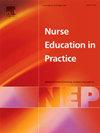What makes a good nursing education: Meeting the needs of students and society in a free-market education system – cluster analysis of United Kingdom universities
IF 3.3
3区 医学
Q1 NURSING
引用次数: 0
Abstract
Aim
Examine quality of education through classification of universities providing undergraduate pre-registration nursing courses in the United Kingdom using data from university league tables.
Background
Educational quality for nursing courses can be defined in many ways. University league tables are often used, but it can be difficult to interpret these because of the diversity of measures. These include educational input and output measures, but are not patient focussed.
Design
Cluster analysis of league table data.
Methods
Data were from the Complete University and Guardian University League Tables. Cluster analysis was undertaken using euclidean distance and average linkage. Data were scaled by turning each value into a percentage of the maximum possible score.
Results
Careers and graduate prospects for nurses are high. Satisfaction with teaching and feedback are closely related and while these broadly cluster with research quality but there was a weak relationship between research quality and overall student satisfaction (correlation −0.008, SE 0.049, p = 0.869, adjusted R2 = −0.014). There was no clear pattern and few universities excelled in all areas.
Conclusions
Traditional methods of ranking universities does not fit nursing well, where employment is higher and research quality lower than other subjects. There was no clear pattern in university results. Countries considering a free-market approach to nurse education should consider how they will meet the needs of students and health and social care services, while promoting research. The quality of nursing education should include broader measures of societal value and address the theory-practice gap.
什么是好的护理教育?在自由市场教育体系中满足学生和社会的需求--对英国大学的分组分析
目的利用大学排名表的数据,通过对英国提供本科预注册护理课程的大学进行分类,检查教育质量。护理课程的教育质量可以通过多种方式来定义。经常使用大学排行榜,但由于衡量标准的多样性,很难解释这些排行榜。这些措施包括教育投入和产出措施,但不是以病人为重点。设计对排行榜数据进行聚类分析。方法数据来源于《英国大学排行榜》和《卫报大学排行榜》。采用欧氏距离和平均连锁进行聚类分析。通过将每个值转换为最大可能得分的百分比来缩放数据。结果护士就业和毕业前景良好。教学满意度和反馈密切相关,虽然这些与研究质量广泛聚集,但研究质量与总体学生满意度之间的关系较弱(相关性- 0.008,SE 0.049, p = 0.869,调整后R2 = - 0.014)。没有明确的模式,很少有大学在所有领域都很出色。结论传统的大学排名方法不适用于护理专业,护理专业的就业率较高,科研质量较其他专业低。大学的成绩没有明显的规律。考虑采用自由市场方法进行护士教育的国家应考虑如何在促进研究的同时满足学生以及保健和社会护理服务的需要。护理教育的质量应包括更广泛的社会价值措施,并解决理论与实践的差距。
本文章由计算机程序翻译,如有差异,请以英文原文为准。
求助全文
约1分钟内获得全文
求助全文
来源期刊

Nurse Education in Practice
NURSING-
CiteScore
5.40
自引率
9.40%
发文量
180
审稿时长
51 days
期刊介绍:
Nurse Education in Practice enables lecturers and practitioners to both share and disseminate evidence that demonstrates the actual practice of education as it is experienced in the realities of their respective work environments. It is supportive of new authors and will be at the forefront in publishing individual and collaborative papers that demonstrate the link between education and practice.
 求助内容:
求助内容: 应助结果提醒方式:
应助结果提醒方式:


